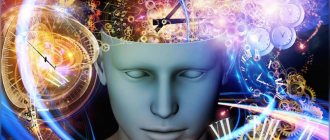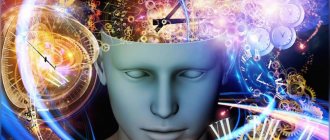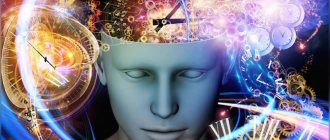The lowest level of development of the perceptual psyche
0
(0)
The perceptual psyche is the highest stage of development of mental reflection. It is characterized by the reflection of the objective components of the environment as integral units, while with the elementary sensory psyche there was a reflection of only their individual properties. Object perception necessarily presupposes a certain degree of generalization, the appearance of sensory ideas. Animals that have reached the level of perceptual psyche are characterized by an active search for positive stimuli. At the lowest level of development of the perceptual psyche are higher invertebrates - cephalopods and arthropods (insects, crustaceans, arachnids, centipedes and others). The most widespread class of insects in nature is represented by the largest number of species (4/5 of all known species), living in all climatic zones on land, in soil, in water and in the air. All these animals have complex, highly differentiated sensorimotor systems, the effectiveness of which is ensured by the high level of development of the central nervous system. In general, cephalopods and arthropods are characterized by a large concentration of nervous elements. This increases the ability to control individual organ systems and raises the overall morphophysiological level of the body as an integral unit. In arthropods, as in annelids, the basis of the entire nervous system is formed by metamerically located ganglia, connected to each other by intersegmental nerve trunks. Due to the pronounced cephalization in the brain of arthropods, the fused ganglia formed a powerful brain in the form of a complex suprapharyngeal node, consisting of three sections. The anterior section, in which the associative and coordinating centers are located, is more developed than the rest. A pair of very large and complexly arranged optic lobes that innervate the compound eyes are also associated with this department. The greatest development of the anterior part of the brain is observed in insects with particularly complex behavior - in bees and ants. The middle section of the brain innervates the antennae, and the posterior section innervates the mouth area and, in addition, is closely connected with the sympathetic nervous system. In cephalopods, the nervous system is organized according to the stellate type. The concentration and fusion of their nerve ganglia led to the formation of a common peri-esophageal system of cerebral ganglia, in which the optic ganglia are distinguished by their size, often exceeding the size of the cerebral ganglia themselves. Another feature of the nervous system of higher cephalopods is the large diameter (up to a millimeter or more) of effector nerves, which increases the speed of nerve impulses.
If you find an error, please select a piece of text and press Ctrl+Enter.
How helpful was this material?
Rate it on a five-point scale!
Average rating 0 / 5. Votes: 0
Be the first to rate this material.
A.N. Leontiev
STAGE OF PERCEPTUAL PSYCHE1
Following the stage of the elementary sensory psyche, the second stage of development can be called the stage of the perceptual psyche. It is characterized by the ability to reflect external objective reality no longer in the form of individual elementary sensations caused by individual properties or their combination, but in the form of a reflection of things.
The transition to this stage of mental development is associated with a change in the structure of animal activity, which is prepared at the previous stage.
This change in the structure of activity consists in the fact that its previously outlined content, which objectively relates not to the object itself to which the animal’s activity is directed, but to the conditions in which this object is objectively given in the environment, is now highlighted. This content is no longer associated with what stimulates activity as a whole, but responds to the special influences that cause it.
So, for example, if a mammal is separated from food by a barrier, then it will, of course, go around it. This means, as in the behavior of a fish described above in a partitioned aquarium, in the activity of this animal we can identify some content that objectively relates not to the food itself, to which it is directed, but to the obstacle, which represents one of those external conditions in which it occurs. this activity. However, there is a big difference between the described activities of fish and mammals. It is expressed in the fact that, while in fish, when the obstacle is subsequently removed, this content of activity (detour movements) is preserved and disappears only gradually.
1Leontyev A.N.
Problems of mental development. 2nd ed. M.: Publishing house Mosk. Univ., 1981. pp. 240-248.
362 Topic 4.
The emergence and development of the psyche
but higher animals in this case usually go straight to the food. This means that the influence towards which the activity of these animals is directed no longer merges with the influence from the obstacle; both act for them separately from each other. The direction and final result of the activity depend on the first, and how it is carried out, i.e., the method of its implementation, for example, by bypassing an obstacle, depends on the second. We will call this special composition or aspect of activity, corresponding to the conditions in which the object stimulating it is given, an operation.
It is precisely the separation of operations in activity that indicates that the properties affecting the animal, which were previously, as it were, side by side for it, begin to be divided into groups: on the one hand, interrelated properties appear that characterize the object to which the activity is directed, and on the other hand, are the properties of objects that determine the very method of activity, i.e. operation. If at the stage of the elementary sensory psyche the differentiation of influencing properties was associated with their simple unification around the dominant stimulus, now for the first time processes of integration of influencing properties into a single holistic image arise, their unification as properties of one and the same thing. The surrounding reality is now reflected by the animal in the form of more or less dismembered images of individual things.
Most of the existing vertebrates stand at different levels of the stage of perceptual psyche. The transition to this stage is apparently associated with the transition of vertebrates to a terrestrial lifestyle.
The emergence and development of the perceptual psyche in animals is due to a number of significant anatomical and physiological changes. The most important of them is the development and change in the role of distant (acting at a distance) sense organs, primarily vision. Their development is expressed in the fact that both their significance in the general system of activity and the form of their anatomical relationships with the central nervous apparatus change. If at the previous stage of development the differentiation of sense organs led to the identification of dominant organs among them, then in vertebrates the leading organs increasingly become organs that integrate external influences. This turns out to be possible due to the simultaneous restructuring of the central nervous system with the formation of the forebrain, and then the cerebral cortex (for the first time in reptiles). <…>
At the same time, the organs of external movements also develop - these “natural tools” of animals, allowing them to carry out complex operations required by life in a terrestrial environment (running, climbing, chasing prey, overcoming obstacles, etc.). The motor functions of animals are also increasingly corticalized (transitioned into the cerebral cortex), so that the full development of operations in animals occurs in connection with the development of the cortex.
Leontyev A.N.
Perceptual psyche stage 363
Thus, if in lower vertebrates their activity is still associated primarily with the underlying centers (subcortical ganglia), then in the future it becomes increasingly dependent on the cortex, changes in the structure of which reflect its entire subsequent development.
The separation of operations, which characterizes the stage of the perceptual psyche, gives rise to the development of a new form of consolidation of animal experience, consolidation in the form of motor skills, in the narrow sense of the term.
Sometimes a skill refers to any connections that arise in an individual's experience. However, with such an expanded understanding of skill, this concept becomes very vague, covering a huge range of completely different processes, ranging from changes in the reactions of ciliates to complex human actions. In contrast to such an unjustified expansion of the concept of skill, we will call only fixed operations skills.
This definition of a skill coincides with the understanding of skills first put forward in our country by V.P. Protopopov, who experimentally showed that motor skills in animals are formed from the motor elements of overcoming an obstacle, that the content of the skills is determined by the nature of the obstacle itself, the stimulus (i.e. the main stimulating influence) affects the skill only dynamically (on the speed and strength of consolidation of the skill) and does not affect its content1.
The motor elements that make up the skills of animals can be of a different nature: these can be both specific, innate movements, and movements acquired through previous experience; finally, these can be movements fixed in the process of those random motor tests that the animal makes in the process of forming this skill.
Clearly expressed skills in the proper sense are observed for the first time only in animals that have a cerebral cortex. Therefore, the physiological basis for the formation of skills should be considered the mechanism of formation and consolidation of systems of cortical conditioned nervous connections.
During the transition to the stage of the perceptual psyche, the sensory form of consolidation of experience also changes qualitatively. Animals experience sensory representations for the first time.
The question of the existence of ideas in animals is still a matter of debate. However, a huge number of facts convincingly indicate that animals have ideas. <…>
Thus, along with a change in the structure of animal activity and a corresponding change in the form of their reflection of reality, a restructuring also occurs in the memory function. Before, on
1 See Protopopov V.P.
Conditional formations of motor skills and their physiological characteristics. Kharkiv; Kyiv, 1935.
364 Topic 4.
The emergence and development of the psyche
stage of the elementary sensory psyche, this function was expressed in the motor sphere of animals in the form of changes under the influence of external influences of movements associated with the animal’s stimulating influence, and in the sensory sphere - in the consolidation of the connection of individual influences. Now, at this higher stage of development, the mnemonic function appears in the motor sphere in the form of motor skills, and in the sensory sphere in the form of primitive figurative memory.
During the transition to the perceptual psyche, the processes of analysis and generalization of the external environment affecting animals undergo even greater changes.
Already at the first stages of mental development, one can observe the processes of differentiation and unification of individual influences by animals. If, for example, an animal that previously reacted equally to two different sounds is placed in such conditions that only one of these sounds is associated with a biologically important effect, then the other gradually ceases to cause any reaction in it. These sounds are differentiated from each other; the animal now reacts selectively. On the contrary, if a number of different sounds are associated with the same biologically important effect, then the animal will respond equally to any of them - they will acquire the same biological meaning for it. Their primitive generalization occurs. Thus, within the stage of the elementary sensory psyche, processes of both differentiation and generalization by animals of individual influences and individual influencing properties are observed. It is important to note that these processes are not determined by an abstract ratio of influences, but depend on their role in the activity of the animal. Therefore, whether animals can easily differentiate between different influences or not, and whether their generalization occurs or not depends not so much on the degree of their objective similarity, but on their specific biological role. For example, bees easily differentiate shapes close to those of a flower, but find it difficult to distinguish even clearly distinct abstract shapes (triangle, square, etc.).
This position remains valid at further stages of development of the animal world. Dogs, for example, react even to insignificant odors of animal origin, but do not react to the smell of flowers, cologne, etc. (Passy and Binet)1. In general, if a given smell acquires a biological meaning for a dog, then it is able to distinguish it very subtly; According to special studies, a dog can distinguish under experimental conditions the smell of organic acids in an insignificant solution - 1:1,000,000.
See Henning H.
Geruchversuche am Hund // Zeitsch. fur Biol. 1921. Bd. 70.
Leontyev A.N.
Perceptual Psyche Stage 365
The main change in the processes of differentiation and generalization during the transition to the perceptual psyche is expressed in the fact that in animals differentiation and generalization of images of things arise. <…>
<…> We observe two interconnected processes: the processes of transferring an operation from one specific situation to another, objectively similar to it, and the processes of forming a generalized image of a thing. Emerging along with the formation of an operation in relation to a given thing and on its basis, the generalized image of this thing allows the transfer of the operation to a new situation in the future; in this process, due to a change in the objective conditions of activity, the previous operation comes into some inconsistency with them and therefore is necessarily modified and rebuilt. Accordingly, the generalized image of a given thing is also restructured, clarified and, as it were, absorbs new content, which, in turn, leads to the possibility of further transfer of the operation to new objective conditions, requiring an even more complete and correctly generalized reflection of them by animals.
A.N.Leontiev STAGE OF INTELLIGENCE1
The psyche of most mammalian animals remains at the stage of the perceptual psyche, but the most highly organized of them rise to one more stage of development.
This new, higher stage is usually called the stage of intellect (or “manual thinking”).
Of course, animal intelligence is not at all the same as human intelligence; There is, as we will see, a huge qualitative difference between them.
The stage of intelligence is characterized by very complex activities and equally complex forms of reflecting reality. Therefore, before talking about the conditions for the transition to the stage of intelligence, it is necessary to describe the activity of animals at this stage of development in its external expression.
The intellectual behavior of the most highly developed animals - apes - was first systematically studied in experiments carried out by Köhler.
These experiments were designed according to the following scheme.
The monkey (chimpanzee) was placed in a cage. Outside the cage, at such a distance from it that the monkey’s hand could not directly reach it, a bait (banana, orange, etc.) was placed. There was a stick inside the cage. A monkey attracted by a bait could bring it closer to itself only under one condition: if it used a stick. How does a monkey behave in such a situation? It turns out that the monkey first of all begins by trying to grab the bait directly with its hand. These attempts do not lead to success. The monkey’s activity seems to fade away for some time. The animal is distracted from the bait and stops its attempts. Then the activity begins again, but now it takes a different path. Without trying to directly grab the fruit with your hand, both
1Leontyev A.N.
Problems of mental development. 2nd ed. M.: Publishing house Mosk. Univ., 1981. pp. 249-261.
Leontyev A.I.
Intelligence stage 367
Zyana takes a stick, extends it towards the fruit, touches it, pulls the stick back, extends it again and pulls it back again, as a result of which the fruit approaches and the monkey grabs it. The problem is solved.
Numerous other tasks that were posed to anthropoid apes were based on the same principle; To solve them, it was also necessary to apply a method of activity that could not be formed in the course of solving this problem. For example, in the enclosure where the animals were kept, bananas were hung on the top grid, which the monkey could not directly grasp. An empty box was placed nearby. The only possible way to get bananas in this situation is to drag the box to the place over which the bait hangs and use it as a stand. Observations show that monkeys solve this problem without noticeable preliminary learning.
So, if at a lower stage of development the operation was formed slowly, through numerous trials, during which successful movements were gradually consolidated, while other, unnecessary movements were just as gradually inhibited and died out, then in this case in the monkey we observe an earlier period of complete failure - many attempts that do not lead to the implementation of the activity, and then, as if suddenly finding an operation that almost immediately leads to success. This is the first characteristic feature of the intellectual activity of animals.
Its second characteristic feature is that if the experiment is repeated again, then this operation, despite the fact that it was carried out only once, is reproduced, i.e. the monkey solves a similar problem without any preliminary tests.
The third feature of this activity is that the solution to the problem found is very easily transferred by the monkey to other conditions, only similar to those in which this solution first appeared. For example, if a monkey solved the problem of approaching a fruit with the help of a stick, then it turns out that if he is now deprived of the stick, he can easily use some other suitable object instead. If you change the position of the fetus in relation to the cage, if you change the situation at all, the animal still immediately finds the desired solution. The solution, i.e. the operation is transferred to another situation and adapts to this new, somewhat different from the first situation.
Among the numerous data obtained in experimental studies of anthropoid apes, one group of facts should be noted that represent some qualitative originality. These facts suggest that apes are capable of combining two different operations in a single activity.
So, for example, outside the cage where the animal is located, bait is placed at some distance from it. Somewhat closer to the cage, but still out of reach of the animal, is a long stick. Other
368 Topic 4.
The emergence and development of the psyche
stick, shorter, which
You can reach a long stick, but you cannot reach the bait, which is placed in the cage. Know-
OOOOOOOOOOOOOOOOOOOOOOOOOOOOOOO cheat in order to solve the problem,
the monkey must take the bo-
_________________________________ „ get a short stick with it
About a long stick, and then with a
use the power of a long stick to push the bait towards you (see Fig. 1). Rice. 1.
Diagram of a two-phase task Monkeys usually cope with
similar “two-phase” tasks without much difficulty. So, the fourth feature of intellectual activity is the ability to solve two-phase problems. <…>
Köhler believed that the main feature that separates the behavior of these animals from the behavior of other representatives of the animal world and which brings it closer to human behavior is precisely that their operations are not formed gradually, through trial and error, but arise suddenly, regardless of previous experience, as if by guess1. He considered the second sign of intellectual behavior, derived from the first, the ability to remember the solution found “once and for all” and its widespread transfer to other conditions similar to the initial conditions. As for the fact that monkeys solve two-phase problems, Köhler and the authors following him believe that it is based on a combination of both factors: the animal’s “guess” and the transfer of a previously found solution. Thus, they consider this fact as not of fundamental importance.
From this point of view, in order to understand all the uniqueness of the intellectual activity of monkeys, it is enough to explain the main fact - the fact that the animal suddenly found a way to solve the first initial problem.
Köhler tried to explain this fact by the fact that anthropoid apes have the ability to correlate in perception individual distinguished things with each other so that they are perceived as forming a single “integral situation.”
This very property of perception - its structure - is, according to Köhler, only a special case expressing the general “principle of structure”, which supposedly initially lies not only at the basis of the psyche! animals and humans and at the basis of their life activity, but also in the ochobi of the entire physical world.
From this point of view, the “structural principle” can serve as an explanatory principle, but is itself further inexplicable and does not require explanation
1 See Koehler V.
A study of the intelligence of great apes. M., 1930.
Leontyev A.N.
Intelligence stage 369
Of course, the attempt to reveal the essence of intelligence based on this idealistic “Gestalt theory” turned out to be untenable. It is absolutely clear that using the structure of perception to explain the unique behavior of higher animals is insufficient. Indeed, from the point of view of supporters of the “structural principle,” structural perception is characteristic not only of great apes. It is also characteristic of much less developed animals; however, these animals do not exhibit intelligent behavior.
This explanation turned out to be unsatisfactory on the other hand. Emphasizing the suddenness of an intellectual decision and isolating this fact from the content of the animal’s experience, Koehler did not take into account a whole series of circumstances characterizing the behavior of monkeys in the natural conditions of their life.
K. Bühler seems to have been the first to point out that there is something in common between bringing a fruit closer to you with a stick and drawing a fruit growing on a tree towards you with a branch. Further, attention was drawn to the fact that the detours observed in apes can also be explained by the fact that these animals, living in forests and moving from one tree to another, must constantly first “try on” the path, since otherwise the animal may find himself at a dead end in the natural labyrinth formed by trees. Therefore, it is no coincidence that monkeys show a developed ability to solve problems using “workarounds”1.
In later works by psychologists and physiologists, the idea that the explanation of the intellectual behavior of monkeys should be sought primarily in its connection with their usual species behavior in natural conditions of existence began to be expressed even more definitely.
From this point of view, an intellectual “solution” is nothing more than the application in new conditions of a phylogenetically developed method of action. This transfer of mode of action differs from the usual transfer of operations in other animals only in that it occurs within wider boundaries.
So, according to this understanding of the intellectual behavior of monkeys, its main features, identified by Köhler, should be correlated with each other in reverse order. It is not the fact of transfer of the found solution that should be explained by its special nature (suddenness), but, on the contrary, the very fact of the sudden solution of the experimental problem should be understood as a result of the ability of these animals to widely transfer operations.
This understanding of the intellectual behavior of monkeys is in good agreement with some facts and has the advantage that it does not contrast the animal’s intelligence with its individual or species intelligence.
1 See Bühler K.
Fundamentals of mental development. M., 1924.
24 Zak. 2652
370 Topic 4.
The emergence and development of the psyche
experience does not separate intelligence from skills. However, this understanding of intellectual behavior also encounters serious difficulties. First of all, it is clear that neither the formation of an operation nor its transfer to new conditions of activity can serve as distinctive features of the behavior of higher apes, since both of these moments are also characteristic of animals at a lower stage of development. We observe both of these moments, although in a less vivid form, also in many other animals - mammals, birds. It turns out that the difference in activity and psyche between these animals and anthropoid apes comes down to a purely quantitative difference: slower or faster formation of an operation, narrower or wider transfers. But the behavior of anthropoid apes differs from the behavior of lower mammals in a qualitative sense. The use of funds and the special nature of their operations clearly demonstrate this.
Further, the above understanding of animal intelligence leaves the most important thing undisclosed, namely, what constitutes the wide transfer of action observed in monkeys and what is the explanation for this fact.
To answer these questions, it is necessary to once again reverse the features of the intellectual behavior of animals indicated by Köhler and make the starting point for the analysis a third characteristic fact, which, in Köhler’s opinion, is not of fundamental importance - the ability of monkeys to solve two-phase problems.
In two-phase problems, the two-phase nature of any
intellectual activity of the animal. You need to get the stick first, then get the fruit. You need to push the fetus away from you first, and then go around the cage and get it from the opposite side. Reaching the stick itself leads to mastery of the stick, and not of the fruit that attracts the animal. This is the first phase. Without connection with the next phase, it is devoid of any biological meaning. This is the preparation phase. The second phase - using a stick - is already the phase of carrying out the activity as a whole, aimed at satisfying a given biological need of the animal. Thus, if from this point of view we approach the monkeys’ solution to any of the tasks that Köhler gave them, then it turns out that each of them requires two-phase activity: take a stick - bring the fruit closer to you, move away from the bait - seize the bait, turn over the box - get the fruit, etc.
What is the content of both of these phases of the monkey’s activity? The first, preparatory phase is obviously not stimulated by the object at which it is directed, for example, not by the stick itself. If a monkey sees a stick in a situation that requires not using the stick, but, for example, a workaround, then it will, of course, not try to take it. Know-
Leontyev A.N.
Intelligence stage 371
cheat, this phase of activity in the monkey is associated not with the stick, but with the objective relationship of the stick to the fruit. The reaction to this attitude is nothing more than the preparation of the further, second phase of activity - the phase of implementation.
What is this second phase? It is already directed at the object that directly motivates the animal, and is built depending on certain objective-subject conditions. It therefore includes one or another operation, which becomes a fairly strong skill.
Thus, during the transition to the third, highest, stage of animal development, a new complication in the structure of activity is observed. Previously merged into a single process, the activity is now differentiated into two phases: the preparation phase and the implementation phase. The presence of a preparation phase constitutes a characteristic feature of intellectual behavior. Intelligence arises, therefore, for the first time where the process of preparing the opportunity to carry out a particular operation or skill arises.
An essential feature of two-phase activity is that new conditions cause the animal not just to try movements, but to try out various previously developed methods and operations. How, for example, does a chicken behave if it is driven from behind a fence? Trying to get out, she blindly rushes from side to side, i.e. she simply increases her motor activity until, finally, a random movement leads her to success. Higher animals behave differently in the face of difficulty. They also make tests, but these are not tests of various movements, but, first of all, tests of various operations, methods of activity. Thus, when dealing with a locked box, the monkey first tries the habitual operation of pressing the lever; when she fails, she tries to chew the corner of the box; then a new method is used: to enter the box through the door gap; then follows an attempt to chew off the lever, which is replaced by an attempt to pull it out with your hand; finally, when this fails, she uses the last method - she tries to turn the box over (Buytendijk).
This feature of the behavior of monkeys, which consists in the fact that they can solve the same problem in many ways, seems to us the most important evidence that in them, like in other animals at the same stage of development, the operation ceases to be fixedly connected with an activity that corresponds to a specific task, and for its transfer does not require that the new task be directly similar to the previous one.
Let us now consider intellectual activity from the perspective of animals’ reflection of the reality around them.
In its external expression, the first, main, phase of intellectual activity is aimed at preparing its second phase, i.e. is objectively determined by the subsequent activity of the animal itself. Know-
372 Topic 4.
The emergence and development of the psyche
Does this mean, however, that the animal has in mind its subsequent operation, that it is capable of imagining it? This assumption is unfounded. The first phase corresponds to the objective relationship between things. This relationship of things must be reflected by the animal. This means that during the transition to intellectual activity, the form of mental reflection by animals actually changes only in that there is a reflection of not only individual things, but also their relationships (situations).
Accordingly, the nature of transfer and, consequently, the nature of animal generalizations also changes. Now the transfer of an operation is a transfer not only according to the principle of similarity of things (for example, an obstacle) with which this operation was connected, but also according to the principle of similarity of relationships, connections of things to which it corresponds (for example, a branch - a fruit). The animal now generalizes the relationships and connections of things. These generalizations of the animal, of course, are formed in the same way as its generalized reflection of things, i.e. in the process of activity itself.
The emergence and development of animal intelligence has its anatomical and physiological basis in the further development of the cerebral cortex and its functions. What are the main changes in the cortex that we observe at the highest stages of development of the animal world? What is new that distinguishes the brain of higher mammals from the brain of lower animals is the relatively much larger space occupied by the frontal cortex, the development of which occurs due to the differentiation of its prefrontal fields.
As Jacobsen's experimental studies show, extirpation (removal) of the anterior part of the frontal lobes in higher monkeys, who solved a series of complex problems before the operation, leads to the fact that it becomes impossible for them to solve two-phase problems, while the already established operation of getting the bait with the help of sticks are completely preserved. Since a similar effect is not created by the extirpation of any other fields of the cerebral cortex, it can be assumed that these new fields are specifically associated with the implementation of two-phase activity by animals.
A study of the intelligence of great apes shows that human thinking has its real preparation in the animal world, and that in this respect there is no impassable gap between man and his animal ancestors. However, while noting the natural continuity in the development of the psyche of animals and humans, one should not exaggerate their similarities, as is done by some modern animal psychologists, who seek to prove with their experiments with monkeys the supposed eternity and nature-conformity of even such “intellectual behavior” as work for pay and monetary exchange1 .
1CM.Wolfe YB
Effectiveness of Token Rewards for Chimpanzees // Sotr. Psycho]. Monog. 1936. V. XII.
Leontyev A.N.
Intelligence stage 373
Attempts to sharply contrast the intellectual behavior of apes with the behavior of other higher mammals are also incorrect. Currently, we have numerous facts indicating that two-phase activity can be found in many higher animals, including dogs, raccoons and even cats (though in the latter, which belong to the “waiting” animals, only in a very peculiar way).
So, intellectual behavior, which is characteristic of higher mammals and which reaches a particularly high development in apes, represents the upper limit of the development of the psyche, beyond which the history of the development of the psyche of a completely different, new type, characteristic only of man, begins - the history of the development of human consciousness.
Labor activity and the emergence of consciousness. Comparison of the psyche of animals and humans
Your psychologist. The work of a psychologist at school.
Basic psychological concepts of the topic Activity is the universal quality of living matter to interact with the environment. The unconscious is a set of mental processes that are not represented in a person’s consciousness, but have the same influence on his behavior as consciousness. Instinct is a hereditary form of behavior. Intellectual behavior is a type of behavior that is the pinnacle of the mental development of animals and is expressed, first of all, in the animal’s ability to solve some visual and effective problems.A skill is an automated way of performing an action, formed during the exercise. The subconscious is a set of actually unconscious mental processes and states that can have a noticeable impact on a person’s behavior and the content of his consciousness. Psyche is a property of the brain that provides humans and animals with the ability to reflect the impact of objects and phenomena of the real world. Irritability is the ability inherent in all living matter to change its physiological state under the influence of external stimuli. Reflection is the ability of a person’s consciousness to focus on itself. Sensory level of consciousness is the level of consciousness associated with the functioning of the senses. Consciousness is the highest, uniquely human, form of mental reflection of objective reality, mediated by the socio-historical activities of people. Tropisms are changes in the direction of plant movement under the influence of biologically significant stimuli. Levels of development of the psyche of living organisms: irritability, sensitivity (sensations), behavior of higher animals (intellectual, externally conditioned behavior), human consciousness (self-determined behavior). Sensitivity is the ability of some living organisms to perceive stimuli that have a signaling function in relation to biologically significant stimuli.
Brief lecture materials
Essence, functions of the psyche. The psyche is a complex and multifaceted phenomenon. Having analyzed all the existing definitions in psychology, we can identify three of its main characteristics. — The property of living highly organized matter (brain) to reflect objective reality. — The highest form of relationship between living beings and the objective world, expressed in their ability to realize their motives and act on the basis of information about it. — A system of processes and states of mutual transition of objective and subjective attributes of the existence of a living being. So, firstly, the possibility of the existence of the psyche is due to the presence of specific organs - the brain and nervous system. Secondly, living matter, receiving information about the surrounding world, is capable of creating its mental image (subjective and immaterial), which, with a certain degree of accuracy, is a copy of material objects of the real world. Thirdly, the information received by a living being about the surrounding world serves as the basis for regulating the internal environment of the body and shaping behavior, which makes it possible for living organisms to exist for a relatively long time in a constantly changing habitat. In our world, there are a huge number of living beings that have certain mental abilities, but they all differ from each other in the level of mental development: - Irritability is the elementary ability to react selectively to the influence of the external environment. Manifests itself in a reaction to biologically significant factors (light, touch, etc.). — Sensitivity — the general ability to sense — is an objective criterion for the emergence of the psyche. The ability to respond not only to biologically significant, but also to biologically neutral stimuli before direct contact with it. — Behavior is a complex set of reactions of a living organism to the influence of the external environment; adaptive interaction with the environment, mediated by mental and motor activity. The most complex behavior is observed in humans, which is due to the presence of consciousness. — Consciousness is the highest level of mental reflection and regulation, suggesting the ability to form motivated (conscious) and purposeful behavior. Thus, we can distinguish four levels of development of the psyche of living beings: irritability, sensitivity, behavior, consciousness. Only humans have the highest level of mental development—consciousness. Stages of mental development. According to AN. Leontiev, there are three main stages of mental development; each stage is characterized by a specific way of reflecting objective reality by the body and corresponds to its own special form of interaction with the environment. A.N. Leontiev identified three such stages: the elementary sensory psyche, the perceptual psyche and the intelligence of animals. Stage of elementary sensory psyche. Animals at this stage of development are able to reflect only certain properties of external influences (illumination, temperature, density of the environment). Based on such reflection, the organism is able to navigate in a homogeneous (homogeneous) environment. At the stage of the elementary sensory psyche there are protozoa, coelenterates and other lower invertebrates (lowest level); annelids, molluscs (except cephalopods) (highest level). Low-level animals are characterized by poorly differentiated motor activity. Their movements are directed towards favorable environmental conditions (positive taxis) or away from unfavorable ones (negative taxis). For example, protozoa leave a zone of high acidity (negative chemotaxis) or a zone of high or low temperature (thermotaxis). The complexity and expediency of the behavior of an animal at the highest level of this stage can be amazing, but this program of behavior is entirely genetically fixed, innate. This is an instinct - a genetically fixed, inherited program of behavior. Individual variability in the behavior of animals at this stage manifests itself in the form of non-associative learning, such as habituation (habituation) - a change in reaction upon repeated presentation of the stimulus. This reaction is not associative; the connection between a specific stimulus and the behavior of the body is not fixed - the degree of reaction to any stimulus changes. So the freshwater hydra, accustomed to mechanical vibration, stops responding to changes in illumination. Elementary associative learning occurs at the highest stage of the sensory psyche.
Stage of perceptual psyche . The transition of living organisms from a homogeneous habitat to a heterogeneous object environment leads to the need to reflect not only individual properties, but also the holistic image of an object in its separation from other objects and phenomena. This leads both to the complication and differentiation of innate forms of behavior, and to the radical complication of methods of behavior modification. Animals at this stage are characterized by extremely complex and varied behavioral programs. Innate behavior programs are already beginning to require individual adjustment. This can occur both through associative learning - the individual acquisition of new forms of behavior in the process of life, and through special mechanisms for adjusting innate behavioral reactions, such as aversive conditioning, obligate learning and imprinting. These forms provide animals with a more flexible adaptation to environmental conditions. The basis of associative learning is the formation of a temporary connection between two stimuli, one of which was initially indifferent to the animal, and the second played the role of a reward. For the first time in its pure form, such learning was isolated in the experiments of I.P. Pavlova. When an initially indifferent stimulus (conditioned signal) is combined with an irritant that causes a certain reaction in the animal (for example, salivation or withdrawal of a limb), this stimulus, neutral for the body, begins to cause the same reaction, that is, a conditioned reflex. The activity of the animal itself can act as a stimulus for the development of new behavioral reactions. Such learning was studied in detail by K. Lloyd-Morgan and E. Thorndike (learning by trial and error). At the highest level of this stage of mental reflection in animals, a generalization of conditioned reactions occurs. At the perceptual stage of mental development are arthropods, cephalopods, fish (lowest level); higher vertebrates: birds and mammals (highest level). Animal intelligence. The intellectual behavior of animals was first discovered when solving two-phase problems. The first phases of the solution do not carry much biological meaning, since mastery of the stick does not directly lead to the satisfaction of food needs. It has this meaning only in connection with the phase of using a stick to pull up the bait. Only the last phase is directly aimed at satisfying the need for food. In order for an animal to carry out such activity, it is necessary that it reflect the objective relationship between things. This level of reflection is the main characteristic of this stage. Intellectual behavior is characterized by an instant restructuring of existing connections and relationships between objects and the establishment of new adaptive connections in a new situation for the animal. Intellectual behavior is available not only to primates, but also to predators and parrots, which constitute the lowest level of this stage; At the highest level of the stage of animal intelligence are the great apes (gorilla, orangutan, chimpanzee), which are the closest relatives of humans. The main feature of the behavior of animals at this stage is an increase in the proportion of behavior not directly related to nutrition, such as exploratory activity and play. Play behavior is especially characteristic of young animals, but adults are also prone to play behavior. If in animals at the perceptual stage the development of conditioned reflexes can only be carried out to a biologically significant factor (food, etc.), then in animals at the intelligence stage the very opportunity to conduct research activities can be used as a reward. The main features of intellectual behavior include the instrumental activity of animals and the solution of elementary logical problems. So, the main features of the mental activity of animals: 1. All activity of animals is determined by biological motives. 2. All animal activities are limited to visual, specific situations. They are not capable of volitional behavior. 3. The basis of animal behavior is hereditary species programs. Their learning is limited to the acquisition of individual experience, thanks to which species programs adapt to the specific conditions of the organism’s existence. 4. Animals lack the consolidation, accumulation and transmission of generational experience in the form of objects of material culture. At the same time, the human psyche is a natural result of long-term evolution. All essential features of the human psyche have their basis in the animal world. Even such a strictly human activity as speech turned out to be accessible to higher primates in rudimentary forms. And in the human psyche, more primitive levels of regulation continue to be preserved, such as taxis, instincts, reflexes, but these forms of behavior regulation are transformed by a qualitatively new level of regulation - consciousness. The manifestations of the psyche are so multifaceted that it is very difficult to unambiguously determine the functions of the psyche. The psyche plays an important role in the process of interaction between man and the environment. From this point of view, three main functions of the psyche can be distinguished: - reflection of the surrounding reality; — regulation of behavior and activity; - a person’s awareness of his place in the world around him. All these functions are interconnected and are elements of the integrative function of the psyche, which is to ensure the adaptation of humans and other living beings to environmental conditions. Structure of the psyche. All mental phenomena, depending on their content, duration and characteristics, can be divided into three classes: - mental processes; - mental states; - mental properties of the individual. Mental processes are the primary regulators of human behavior; they have such dynamic characteristics as duration and stability. Mental processes can be divided into three groups: - cognitive (sensation, perception, representation, memory, imagination, thinking, speech, attention.); — emotional (emotions, feelings, moods, emotional stress); — strong-willed (decision making, overcoming difficulties, struggle of motives, managing one’s behavior); - sometimes there are unconscious processes that occur in the unconscious and are not controlled by consciousness. Mental processes are interconnected and act as the main factors for the formation of human mental states. Mental states characterize the state of the psyche as a whole and have the properties of stability, duration, direction and intensity. At the same time, they influence the course and outcome of mental processes and can promote or inhibit activity. Mental states include such phenomena as elation, depression, fear, cheerfulness, despondency. Mental properties of a person are the most significant characteristics of a person, ensuring a certain quantitative and qualitative level of human activity and behavior, and are characterized by stability and constancy. These usually include: temperament, orientation, abilities, character. So, the structure of the psyche is formed by mental processes, states and personality traits. Qualitative features and level of development of mental properties, features of the course of mental processes and the most characteristic mental states for a person determine the uniqueness and individuality of each person.
Questions for self-test 1. What is the essence of the psyche as the main subject of psychology. 2. What are the main functions of the psyche? 3. Reveal the levels of mental development. 4. What classes are included in the structure of the psyche? 5. Reveal the essence and features of mental processes in the structure of the psyche. 6. How do mental states differ? 7. What are the characteristics of a person’s mental properties? 8. Expand the stages of mental development according to A.N. Leontiev 9. What is the peculiarity of the animal psyche
Practical tasks Task No. 1. Prepare abstracts for presentation at the seminar “Hypothesis of A.N. Leontiev on the emergence of sensitivity" Task No. 2. Prepare a scientific report on the topic “Modern scientific view of animal behavior.” Task No. 3. Compile a summary of approaches to understanding who has a psyche (anthropopsychism, panpsychism, biopsychism, neuropsychism, the position of A.N. Leontiev and K.K. Platnov)
Individual tasks
Task No. 1. N.N. Ladygina-Kots compared the imitative construction of a chimpanzee and a three-year-old child and revealed interesting facts. Determine which of them relate to the behavior of a chimpanzee, and which ones relate to the behavior of a child? By what signs can this be established? 1. One of them could make a figure from 2 - 3 parts only if there was a sample figure in front of him, the other could complete the task in the absence of a sample, from memory. 2. A typical mistake of one was that he placed the cone-shaped figures on the top rather than on the base. But after they fell, I installed them as needed. Others rarely made such mistakes. 3. Both the chimpanzee and the child made mistakes in the construction of five-element towers, but if one could independently correct the mistakes, the other did this only with the help of the experimenter. 4. The most difficult tasks for one were tasks like constructing a bridge, in which a horizontal element had to be placed on two vertical ones, for the other these were the easiest tasks. Task No. 2. Choose the correct option from the given answers. 1. The following features are characteristic of the elementary sensory level of mental development: a) reflect objects as a whole; b) reflect connections and relationships between objects; c) reflect individual properties of objects; d) set goals and achieve them. 2. A sign of the mental form of elementary reflection in the animal world is: a) mental activity; b) instinct; c) sensitivity; d) reflex. 3. The combination of nervous processes and organs of the human body, which allows you to effectively perform a certain intended action, is called: a) reflex activity; b) dynamic stereotype; c) an acceptor of the results of activities; d) functional systems of the psyche. 4. The most important condition for the development of consciousness in ontogenesis is: a) the development of sense organs; b) formation of upright posture; c) communication with surrounding adults; d) hereditary prerequisites. 5. Consciousness as the highest form of mental reflection and the highest level of self-regulation is characterized by: a) activity; b) intentionality; c) criticality; d) all answers are correct. Task No. 3. Determine which components of consciousness (sensory fabric of consciousness, meanings or personal meaning) are discussed in the following descriptions. Explain your answer. 1. I see, I see bright clusters of rowan trees. I see, I see her house number one... 2. One says to the other: “I wanted to make fun of you, but it turned out - I broke it!” 3. “What a delight these fairy tales are!” (A.S. Pushkin.) 4. “I’ll give you an A for your answer!”
Topics of reports and abstracts 1. Psychological studies of highly developed instinctive forms of animal behavior. 2. Do animals have intelligence? 3. Animal skills and intelligence. 4. Development of human consciousness in ontogenesis. 5. The problem of the unconscious in psychology. 6. Dreams and their origin. 7. Altered states of consciousness 8. Unconscious processes
Source: Salavatulina L.R. General psychology: workshop for independent work of students: educational method. allowance / L.R. Salavatulina. - Chelyabinsk: South Ural Center RAO, 2022. - 257 p.
Human psyche as a system, its structure, components and elements
2.1. Psyche and body. Brain and psyche
Psyche
(from ancient Greek, spiritual) - the ability of a subject to actively reflect objective reality, which arose as a result of the interaction of highly organized living beings with the outside world.
Basic functions of the psyche:
- reflection of the surrounding world;
- ensuring the integrity of the body;
- regulation of behavior.
The integrative function of the psyche is to ensure the body’s adaptation to environmental conditions.
The psyche is the result of the complex activity of the nervous system, the structural and functional unit of which is the neuron (nerve cell).
Neuron
(
from ancient Greek fiber
)
is an electrically excitable cell that processes and transmits information through electrical and chemical signals.
Rice.
2.1. Neuron structure
Each neuron consists of a cell body (or soma
), which contains the cell nucleus.
From the cell body of a neuron grow dendrites
(short branches that receive nerve impulses going to the neuron) and
an axon
(a long thin tubular process that transmits nerve impulses from the neuron).
Neurons form chemical or functional connections with other neurons, making up a neural network
(eng. biological neural network);
points of conjugation (contact) of neurons in the network are called synapses
.
Stimulation of excitatory synapses causes a nerve impulse
, running along the axon.
Signals travel from one neuron to another through a complex electrochemical reaction. The transmission of signals from the sense organs to the brain and spinal cord is carried out by sensory neurons
, and from the brain and spinal cord to the muscles and glands by
motor neurons
.
Nerve
- a sheathed bundle of axons in the peripheral nervous system, which is the path for electrochemical nerve impulses transmitted along each of the axons to the peripheral organs.
Nervous system
humans and mammals consists of
a central nervous system
(
brain
and
spinal cord
) and
a peripheral nervous system
(cranial and spinal nerves, nerve plexuses).
Peripheral nervous system
consists of
the somatic nervous system
and
from the sensory organs, muscles, skin, and
the autonomic
nervous
system
, which regulates the activity of internal organs, glands, blood and lymph vessels.
Brain
- the center of the nervous system, the physiological functions of which are to centrally control all other organs of the body. The brain consists of the central brainstem, limbic system and cerebrum.
Rice.
2.2. Main parts of the brain (cross section)
To the central trunk
relate:
- medulla oblongata
, whose functions include protective reflexes (coughing, sneezing, swallowing, vomiting), vital reflexes (breathing), regulation of vascular tone; - cerebellum
, whose functions are coordination of movements, regulation of balance and muscle tone, muscle memory; - thalamus
, responsible for the redistribution of incoming sensory information (with the exception of smell) to the cerebral cortex; - hypothalamus
, which regulates all body functions (except heart rate, blood pressure and spontaneous respiratory movements), as well as human emotions and behavior.
Reticular formation
(from Latin rete - network) - a structure consisting of more than 100 small neural networks of the brain stem and upper spinal cord that filters incoming sensory information and transmits it to the limbic system and cerebral cortex.
The limbic system located within the thalamus
participates in the regulation of the functions of smell and internal organs, controls instinctive behavioral reactions, emotions, memory, and plays an important role in learning.
Big brain
(cerebrum) consists of two
cerebral hemispheres
, covered with a convoluted
cortex
, which plays a key role in the implementation of higher mental functions - memory, attention, perception, thinking, language and consciousness.
Left hemisphere
The brain specializes in expressive and impressive speech, reading, writing, verbal memory, verbal and abstract thinking, is focused on forecasting,
the right
is responsible for visual-spatial orientation, non-verbal memory, and specific figurative thinking.
Vegetative
(
autonomic
)
nervous system
consists of two systems:
- sympathetic
, which mobilizes the body’s nervous system in stressful situations, increasing metabolism and increasing tissue excitability; - parasympathetic
, whose functions are associated with actions that do not require an immediate reaction (salivation, lacrimation, urination, digestion, defecation).
The autonomic nervous system plays an important role in emotional reactions because its fibers mediate the functioning of smooth muscles and glands. Endocrine glands
(
endocrine glands
) synthesize and release hormones into the bloodstream that affect emotional state and motivation.
The human psyche is influenced by heredity
.
The molecular unit of heredity of a living organism is genes
- sections of DNA and RNA that store information about the creation and maintenance of body cells and transmit genetic characteristics to offspring.









